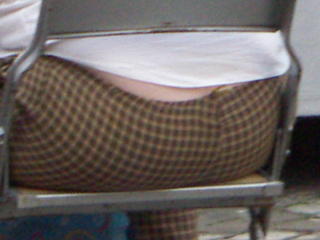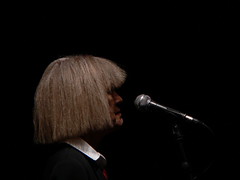Intro
As I headed down the stairs, ready to go, I found IVN watching a Count Basie documentary on ARTE. It was very well done: lots of music footage and a pianist on hand to demonstrate some specific ways of piano playing Basie had pioneered. It ended with a massive jam featuring Ben Webster, Coleman Hawkins, Roy Eldridge and many others taking choruses. I thought this an auspicious start to a day of jazz festivaling.
We stopped briefly on the north-western outskirts of Brussels to pick up the notorious LeMo and another friend (PM), and discussed the growth patterns of magnolias.
Randy Weston awaited us in deSingel's Blue Room, but before that there was the inevitable costly detour past the vendors' tablefuls of CDs/LPs/etc. PM picked up 30+ CDs. I remained reasonable: Ran Blake's Suffield Gothic and a November 1968 issue of Actuel, because Jacques Coursil was on the cover. LeMo had mentioned him to me during the drive. Two appearances in one day by a Martiniquan musician I'd never heard of previously was a sign impossible to ignore.
Such a lovely giant
I'd never seen Randy Weston before, nor heard much of his music, but heard about him a fair amount. The solo concert was a sort of "Weston plays Weston" career-spanning retrospective thing. He started out with a medley of early pieces (two spirituals and two waltzes), then discussed and played his discovery of Africa and its music, elaborated on some blues-based originals and went on to combine Congolese children's songs with Gnawa music. He strung together "Caravan," "Well You Needn't" and several others for a cognescenti-pleasing encore.
Weston rapidly established his distinguishing features: a touch that is both strong and supple (Leonard Feather might have called it virile), contrasting ideas that segue or interrupt each other often, but without being unpredictable, exactly. His playing was too muscular to be considered fanciful, but its nuances were both dramatic and fine-grained, shifting in mood, tone, weight, register and lyricism.
As Weston covered swing, blues, originals and standards, evoked Africa and childhood, creolised classical music, what he was really doing began to emerge. He was playing the whole (or, at least a large part) of the Black American experience, from sweet to discordant, its European parts, its African parts, its naivety and its horror.
Transition; passing on
The venue changed for the day's three remaining concerts. Several tents had been set up behind Park Van Den Brandt's castle (a real castle: it had moats), a big one containing the main stage, smaller ones for various purposes, such as protecting the smooth-voiced Marc Van Den Hoof as he serenaded radio listeners.
Things were meant to start at 5PM, but there was a 30-minute delay as paramedics treated what seemed to be (I was quite far away, I'm just repeating IVN's expert hypothesis) a heart attack in the first few rows. I don't know if the person made it through. It was odd.
And now for the Europeans (sort of)
Bzzz Pük is made up of French trombonist Geoffroy De Masure, Mauritian electric bassist Linley Marthe and AKA Moon drummer Stéphane Galland. Franco-Vietnamese guitarist Nguyen-Lê sat in. De Masure, as is often the case, was the most interesting musician. The spirit in which he plays seems to me quite different from that of his colleagues, whether in BP or other bands like Octurn. He always attempts to bring some levity to the seriousness of complicated composed meters, some swing to the egghead funk. I can't help but wonder if there aren't other musicians with whom the particular balance he seems to be seeking could be better realised. BP veered between spacey jazz-rock and aggressive jazz-rock, loud guitar-rock and some blissfully straight-forward dancey funk.
Galland was, as always, somewhat super-human, but, more than I did a few years ago, I find myself longing for less clutter, for some spring cleaning, for someone to tell him, loudly and repeatedly, that less really is more. The occasional stretches of lean 4/4 funk made it all so obvious. Apart from obnoxious sounds from a keyboard/sampler of some sort, Lê added big rock solos that got predictable cheers.
Mid-afternoon tea
Fred Hersch's Trio + 2 was at one of the opposite ends of the spectrum from BP. Drummer Nasheet Waits and bassist John Hebert (oddly, the same pair as in Andrew Hill's trio) held a loose grip on the pulse, tightening it only slightly on arranged unison parts. Often, a rhythm section rumble lay underneath the piano's quiet reflections, as on the beautiful, sad "Black Dog Pays a Visit."
Hersch tackled some issues near to his heart with sincerity and a good sense of drama: "Out Someplace," inspired by the killing of Matthew Sheppard, began with small, high-pitched drones, scrapes and unpitched air, creating a solemn setting for the piano to expose a long-note melody later taken up with dignity by Ralph Alessi's trumpet. The brief return of the little noises at the end made for a chilling conclusion.
Overall, the music was a bit too polite and polished. Tony Malaby's feature on "Rain Waltz" (during which it actually did start raining: a downpour, rather than the moody drizzle the song hints at) exemplified the problem: pretty, controlled notes, but clearly, there was little room for him to dig in and stretch out.
Not him, the other one
The massed thousands finally got what they had been waiting for. I had only read of Wayne Shorter's triumphant return to small group acoustic music, so expectation was high. Danilo Perez is not Herbie Hancock. Brian Blade is not Tony Williams. Patitucci isn't Carter. Wayne Shorter is Wayne Shorter, but not that Wayne Shorter. The antithesis of a jukebox: he'll play his hits for you, but you'll have to accept that he's not playing what you put your 50 eurocents in for. "Forget the rules, I'm going for the unknown," was the newspaper's headlining quote. For once, the declaration was more than empty hype.
The group abandoned structure for flow, bar lines for an organically undulating tissue of improvisation and interaction. Instruments dropped in and out when they felt it necessary, rather than for effect or to adhere to a form. Shorter played tenor, mostly, but often in a very high register, for a very fragile, breathy sound, which complemented his tentative (in a good way) phrasing. When he dipped lower, he took on a firmer sound and a yearning beauty. When he did move to soprano, he was more affirmed and decisive: he ended the concert with it and an almost absurdly long series of piercing one-note blasts.
Perez was probably the most legible member of the group, his richly and delicately chorded accompaniment providing a nice point of entry and contrast to Patituci and Blade's hard-nosed layers of sound (as much, and sometimes more, sound than rhythm). And yet, the latter two would sometimes slip into something recalling a DeJohnette/Holland early-'70s-with-Miles groove.
I thought back to Andrew Hill again. Shorter and Hill, two grand old men making new, mysterious music, well outside the canons of modern jazz they helped establish, thereby making clear what they were really doing all those years ago. The crowd cheered long and hard. I was a bit puzzled by the unanimous response: it felt strange for a music that thrived on doubt to be welcomed so unambiguously.








